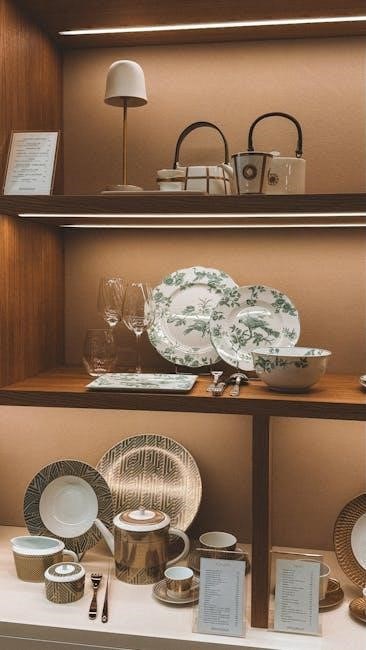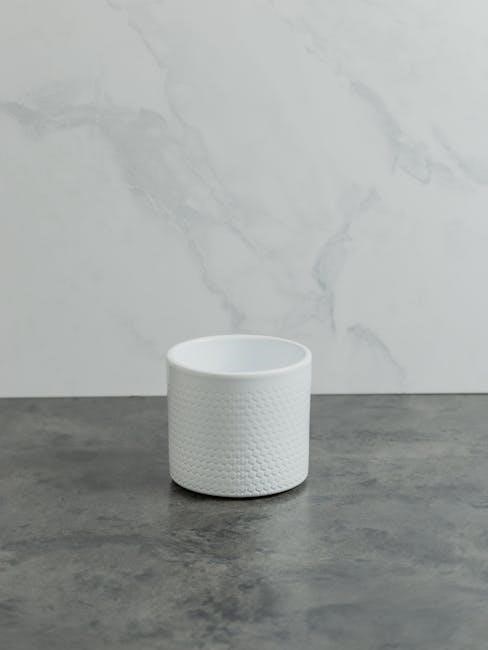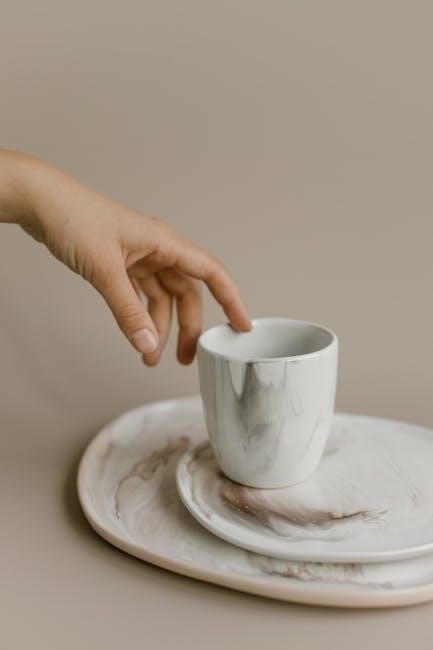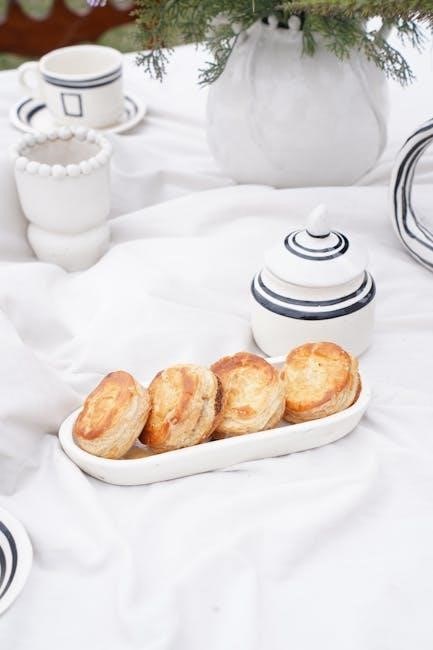Meissen porcelain, originating from Meissen, Germany, is renowned as the first European porcelain, celebrated for its exceptional craftsmanship, intricate designs, and historical significance in ceramics. This introduction explores its origins and artistic legacy, setting the foundation for understanding its identification and value.
Historical Background of Meissen Porcelain
Meissen porcelain traces its origins to the early 18th century when alchemist Johann Friedrich Böttger, under the patronage of Augustus the Strong, Elector of Saxony, discovered the formula for European porcelain in 1708. The first factory was established in Meissen, Germany, in 1710, marking the beginning of a legacy in ceramics. The manufactory quickly gained acclaim for its high-quality porcelain, blending artistic craftsmanship with technical innovation. Key figures like Johann Joachim Kändler contributed to its iconic designs. The Blue Onion pattern, introduced in the 1730s, remains a hallmark of Meissen. This historical foundation laid the groundwork for its reputation as a leader in porcelain production, combining Saxon ingenuity with artistic flair to create timeless masterpieces.
Significance of Meissen Porcelain in Art History
Meissen porcelain holds a pivotal place in art history as the pioneer of European porcelain production, setting standards for craftsmanship and design. Its intricate figurines, such as those designed by Johann Joachim Kändler, exemplify the Rococo style, influencing art globally. The Blue Onion pattern, an enduring motif, showcases its technical mastery. Meissen’s work not only elevated porcelain to a fine art form but also inspired other European manufacturers, shaping the course of ceramic art. Its legacy continues to be celebrated in museums and collections, underscoring its enduring impact on the decorative arts.

Key Characteristics of Meissen Porcelain
Meissen porcelain is distinguished by its translucent whiteness, fine paste, and precise craftsmanship. Its intricate designs, including the famous Blue Onion pattern, and masterful glazing techniques set it apart as a pinnacle of ceramic artistry, reflecting both technical excellence and artistic innovation.
Material and Manufacturing Techniques
Meissen porcelain is crafted from a unique blend of kaolin, feldspar, and quartz, firing at high temperatures to achieve its signature translucency and durability. The manufacturing process involves meticulous hand-painting and intricate moldwork, with each piece often requiring multiple firings. The use of traditional techniques passed down through generations ensures consistency and quality, making Meissen pieces highly prized by collectors. The combination of superior materials and expert craftsmanship results in porcelain of exceptional beauty and longevity, distinguishing it from other brands and contributing to its enduring value in the art market.
Distinctive Designs and Patterns

Meissen porcelain is celebrated for its intricate and iconic designs, which have become synonymous with elegance and artistry. The famous Blue Onion pattern, introduced in the 18th century, remains one of the most recognizable motifs, featuring cobalt-blue onion and vine-leaf motifs. Other notable designs include the vibrant Chinoiserie scenes, floral patterns, and figural sculptures that reflect the cultural and artistic influences of their time. The meticulous craftsmanship and attention to detail in these designs set Meissen apart from other porcelain brands. Over the centuries, the factory has continued to innovate while maintaining its traditional aesthetic, resulting in a wide range of distinctive styles that appeal to collectors and connoisseurs alike.
Color Palette and Glazing Techniques
Meissen porcelain is distinguished by its rich and vibrant color palette, achieved through advanced glazing techniques. The factory perfected the use of cobalt-blue underglaze, a hallmark of Meissen wares, creating intricate designs that remain iconic. Overglaze enamels in shades like iron red, gold, and various pastels add depth and luminosity. The glazing process involves multiple firings, ensuring durability and a smooth, glass-like finish. These techniques not only enhance the aesthetic appeal but also contribute to the porcelain’s value. The meticulous application of colors and glazes reflects the craftsmanship that has made Meissen a benchmark in ceramics, making these elements crucial for identification and valuation among collectors and enthusiasts.

Identification of Meissen Porcelain
Meissen porcelain is identified by its distinctive marks, such as the crossed swords logo, and the exceptional quality of its painting and glazing techniques, ensuring authenticity and value.
Understanding Meissen Marks and Signatures
Meissen porcelain is renowned for its distinctive marks, which play a crucial role in authentication. The most iconic mark is the crossed swords logo, symbolizing the brand’s heritage. Over time, the marks have evolved, with variations such as the addition of dots or letters, helping to date the pieces. Early examples often feature a single sword, while later pieces include more intricate details. Signatures from artists or gilders may also appear, adding to the piece’s provenance and value. These marks are meticulously documented, allowing experts to trace the origins and era of each item. Understanding these markings is essential for identifying genuine Meissen porcelain and distinguishing it from reproductions or lesser-quality imitations.
How to Distinguish Meissen from Other Porcelain Brands
Distinguishing Meissen porcelain from other brands requires attention to detail and knowledge of its unique characteristics. Meissen’s craftsmanship is unparalleled, with intricate designs, flawless glazing, and a distinctive color palette. The iconic crossed swords mark, often accompanied by additional symbols or numbers, is a hallmark of authenticity. Compared to other brands, Meissen’s porcelain exhibits exceptional whiteness, translucency, and a fine, delicate texture. The designs often feature classical motifs, such as the Blue Onion pattern, which are instantly recognizable. Additionally, Meissen pieces typically have a more refined and precise execution, setting them apart from lesser-quality reproductions. Consulting experts or referencing historical catalogs can further aid in verifying the authenticity of a piece, ensuring it meets the high standards associated with the Meissen legacy.
Role of Provenance in Identification
Provenance plays a crucial role in the identification and valuation of Meissen porcelain, as it traces the piece’s ownership history and exhibition or publication records. Documentation, such as receipts, certificates of authenticity, or auction records, can significantly enhance credibility. Pieces with a documented history of ownership by notable collectors or royal families are highly prized. Additionally, exhibition histories in reputable museums or galleries further validate authenticity. Provenance also helps date the piece and link it to specific historical periods or artists, crucial for distinguishing genuine Meissen works from reproductions. A well-documented provenance not only authenticates the piece but also increases its value in the market, making it a key factor for collectors and appraisers alike. This historical context is invaluable for understanding the piece’s significance and ensuring its legitimacy.

Evaluating the Value of Meissen Porcelain
Evaluating Meissen porcelain involves assessing condition, age, rarity, and market demand. Expert appraisals and auction results provide insights into its monetary worth, guiding collectors and investors.

Factors Influencing the Value of Meissen Pieces
The value of Meissen porcelain is determined by various factors, including its age, condition, rarity, and historical significance. Pieces from earlier periods, such as the 18th century, typically command higher prices due to their historical importance and limited availability. The presence of intricate designs, like the iconic Blue Onion pattern, can also elevate value. Additionally, the condition of the piece plays a crucial role; items with minimal restoration or wear are more desirable. Provenance further enhances value, with pieces tied to notable collections or historical figures often fetching premium prices at auctions. Market demand and trends also influence valuation, making expert appraisals essential for accurate assessments.
Market Trends and Demand for Meissen Porcelain
Market trends for Meissen porcelain reflect a steady demand driven by collectors and connoisseurs worldwide. The allure of its historical significance and artistic excellence continues to attract investors and enthusiasts. Recent auction results highlight increasing interest in rare and early pieces, with select items fetching record prices. Collectors particularly favor pieces with unique designs, such as the Blue Onion pattern and figurines from the 18th century. The growing popularity of antiques in global markets has further fueled demand, making Meissen porcelain a sought-after commodity. Additionally, the rise of online auctions has expanded accessibility, connecting buyers and sellers across borders. This sustained demand underscores the enduring appeal and value of Meissen porcelain in today’s market.
Expert Appraisals and Auction Results
Expert appraisals play a crucial role in determining the value of Meissen porcelain, leveraging deep knowledge of historical context, craftsmanship, and market demand. Auction results consistently demonstrate the high regard for rare and well-preserved pieces, with select items fetching millions at major auction houses like Christie’s and Sotheby’s. For instance, intricately designed 18th-century figurines and early examples of the Blue Onion pattern often achieve record prices. Appraisers meticulously examine marks, glazing, and provenance to authenticate and value each piece. These evaluations not only set market standards but also highlight the enduring prestige of Meissen porcelain among collectors and connoisseurs, affirming its status as a coveted treasure in the world of antiques and fine art.

Common Mistakes in Meissen Porcelain Identification
Common errors include misidentifying marks, overlooking restoration, and ignoring rarity. Novice collectors often confuse Meissen marks with similar ones from other porcelain brands, leading to inaccurate valuations.
Misidentifying Marks and Patterns
Misidentifying marks and patterns is a common mistake in Meissen porcelain identification. The famous crossed swords mark is often confused with similar symbols used by other manufacturers. Additionally, intricate designs, such as the Blue Onion pattern, can be replicated by lesser-known brands, making it difficult for collectors to distinguish authentic pieces. Over time, slight variations in mark styles and patterns have evolved, further complicating the identification process. Experts emphasize the importance of thorough research and consulting reference materials to avoid such errors. Misidentification can significantly impact the perceived value of a piece, highlighting the need for meticulous examination and verification.
Overlooking Restoration or Repairs
Overlooking restoration or repairs is a frequent oversight in Meissen porcelain identification. Even slight restorations can significantly affect a piece’s value and authenticity. Collectors often fail to detect expertly executed repairs, which may not be immediately visible to the naked eye. Chips, cracks, or missing elements are sometimes skillfully touched up, making it difficult to distinguish between original and restored areas. UV light and magnification can help reveal such interventions. It is crucial to examine pieces thoroughly, as undisclosed repairs can mislead buyers about the item’s condition and provenance. Always seek expert appraisals to ensure the piece’s integrity, as overlooked repairs can drastically reduce its value and authenticity in the eyes of collectors and appraisers.
Ignoring the Importance of Rarity
Ignoring the importance of rarity is a significant mistake in Meissen porcelain identification and valuation. Rare pieces, such as those with unique designs, limited production runs, or historical provenance, command higher values due to their scarcity. Overlooking rarity can lead collectors to underestimate a piece’s worth or misidentify it as more common. For instance, early 18th-century Meissen pieces or those with exceptional craftsmanship are highly sought after and rare. Market demand for such items drives their value, making rarity a critical factor. Failing to recognize this can result in undervaluing or overpaying for a piece. Thus, understanding rarity is essential for accurate appraisals and informed collecting decisions.

Resources for Further Research
Recommended books like “Meissen Porcelain Identification and Value Guide” by Jim and Susan Harran, along with online databases and auction catalogs, provide essential tools for deeper exploration.
Recommended Books and Guides

For in-depth knowledge on Meissen porcelain, “Meissen Porcelain Identification and Value Guide” by Jim and Susan Harran is a definitive resource, offering detailed descriptions, historical context, and valuation insights. Additionally, “Meissen Porcelain: The Art of the Meissen Factory” provides a comprehensive overview of the factory’s history and artistic techniques. Collectors and enthusiasts can also benefit from “The Concise Encyclopedia of Meissen Porcelain,” which features exquisite imagery and expert commentary. These guides are indispensable for identifying genuine pieces, understanding design evolution, and assessing market value. They serve as essential tools for both seasoned collectors and newcomers to the world of Meissen porcelain.
Online Databases and Auction Catalogs
Online databases and auction catalogs are invaluable resources for identifying and valuing Meissen porcelain. Platforms like eBay UK and specialized auction houses such as Christie’s and Sotheby’s provide extensive catalogs featuring Meissen pieces, complete with high-resolution images and detailed descriptions. The Meissen Manufactory’s official website also offers a wealth of information, including historical data and authenticity guidelines. Additionally, databases like the Meissen Collector’s Database and the Porcelain Collector’s Archive offer access to rare and archived pieces, aiding in the verification of patterns and marks. These resources are essential for collectors and enthusiasts, enabling them to research, compare, and authenticate Meissen porcelain effectively. They also serve as a gateway to understanding market trends and the monetary value of specific pieces.
Consulting Experts and Collectors Communities

Consulting experts and engaging with collectors’ communities is a crucial step in identifying and valuing Meissen porcelain. Experts, such as appraisers or historians, can provide detailed insights and authenticate pieces, ensuring accuracy. Collector communities, both online and offline, offer valuable networking opportunities, where enthusiasts share knowledge, experiences, and resources. Platforms like collector forums or social media groups dedicated to Meissen porcelain allow members to discuss rare pieces, share identification tips, and learn from others’ experiences. Additionally, attending collector events or joining specialized clubs can connect you with seasoned collectors and professionals, offering firsthand advice and access to rare or lesser-known information about Meissen porcelain.

